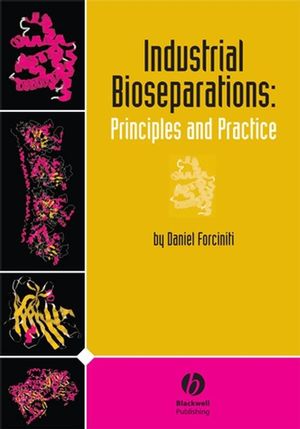Industrial Bioseparations: Principles and PracticeISBN: 978-0-8138-2085-9
Hardcover
336 pages
July 2008, Wiley-Blackwell
 This is a Print-on-Demand title. It will be printed specifically to fill your order. Please allow an additional 15-20 days delivery time. The book is not returnable.
|
||||||
Chapter 1. Introduction to Bioseparations.
a. Statement of the problem.
b. Engineering Developments.
c. Current approaches to bioseparations.
Chapter 2. Thermodynamics.
a. A brief introduction.
b. Thermodynamics of open systems.
c. Thermodynamic analysis of processes.
Chapter 3. Principles of Mass Transfer.
1. Diffusion.
2. Fluxes.
3. Law of conservation of mass.
4. Examples.
Chapter 4. General Properties of Bioproducts.
1. Proteins.
a. Structure.
b. Stability (solubility and aggregation).
c. Separation of complex protein mixtures by two-dimensional electrophoresis.
2. Nucleic Acids.
a. Structure.
b. Properties.
3. Laboratory experiments.
Chapter 5. Cell disruption.
1. General approach to cell disruption.
a. Types of cells.
b. Location of product.
c. Physical Chemistry Properties of Cells (as they relate to disruption).
2. Bead Mills.
3. Homogenizers.
4. Chemical Methods.
5. Biochemical Methods.
6. Laboratory experiments.
Chapter 6. Separation of Solids.
1. General Principles.
a. Flocculation of proteins.
b. Inclusion bodies.
2. Filtration.
a. Conventional Filtration.
b. Ultrafiltration.
3. Centrifugation.
4. Sedimentation.
5. Laboratory experiments.
6. Liquid/liquid extraction.
Chapter 7. Chromatography.
1. General Principles.
2. Gel permeation.
3. Ion Exchange Chromatography.
4. Hydrophobic Interactions Chromatography.
5. Affinity Chromatography.
6. Simulated Moving Bed Chromatography.
7. Laboratory Experiments.
Chapter 8. Protein Precipitation.
1. Precipitation by salting-out.
2. Isoelectric Precipitation.
3. Precipitation by non-ionic polymers.
4. Laboratory Experiments.
Chapter 9. Polishing.
1. Freeze drying.
2. Crystallization.
3. Product Formulation.
4. Laboratory Experiments.
Chapter 10. Separations in a Chip.
1. Introduction to micro-devices.
2. Fluidics.
3. Micro-reactors, micro-mixers, and valves.
4. Chromatography and electrophoresis in a chip.
5. Micro-sensors.
Chapter 11. Design of Separation cascades.
1. General Principles.
2. Examples.
3. Laboratory Projects.
Appendix. Experimental Design.
1. Introduction to Experimental Design.
2. Precision and Accuracy.
3. Descriptive Statistics.
4. Statistical Tests.
5. Examples.
Table of Contents.
Chapter 1. Introduction to Bioseparations.
a. Statement of the problem.
b. Engineering Developments.
c. Current approaches to bioseparations.
Chapter 2. Thermodynamics.
a. A brief introduction.
b. Thermodynamics of open systems.
c. Thermodynamic analysis of processes.
Chapter 3. Principles of Mass Transfer.
1. Diffusion.
2. Fluxes.
3. Law of conservation of mass.
4. Examples.
Chapter 4. General Properties of Bioproducts.
1. Proteins.
a. Structure.
b. Stability (solubility and aggregation).
c. Separation of complex protein mixtures by two-dimensional electrophoresis.
2. Nucleic Acids.
a. Structure.
b. Properties.
3. Laboratory experiments.
Chapter 5. Cell disruption.
1. General approach to cell disruption.
a. Types of cells.
b. Location of product.
c. Physical Chemistry Properties of Cells (as they relate to disruption).
2. Bead Mills.
3. Homogenizers.
4. Chemical Methods.
5. Biochemical Methods.
6. Laboratory experiments.
Chapter 6. Separation of Solids.
1. General Principles.
a. Flocculation of proteins.
b. Inclusion bodies.
2. Filtration.
a. Conventional Filtration.
b. Ultrafiltration.
3. Centrifugation.
4. Sedimentation.
5. Laboratory experiments.
6. Liquid/liquid extraction.
Chapter 7. Chromatography.
1. General Principles.
2. Gel permeation.
3. Ion Exchange Chromatography.
4. Hydrophobic Interactions Chromatography.
5. Affinity Chromatography.
6. Simulated Moving Bed Chromatography.
7. Laboratory Experiments.
Chapter 8. Protein Precipitation.
1. Precipitation by salting-out.
2. Isoelectric Precipitation.
3. Precipitation by non-ionic polymers.
4. Laboratory Experiments.
Chapter 9. Polishing.
1. Freeze drying.
2. Crystallization.
3. Product Formulation.
4. Laboratory Experiments.
Chapter 10. Separations in a Chip.
1. Introduction to micro-devices.
2. Fluidics.
3. Micro-reactors, micro-mixers, and valves.
4. Chromatography and electrophoresis in a chip.
5. Micro-sensors.
Chapter 11. Design of Separation cascades.
1. General Principles.
2. Examples.
3. Laboratory Projects.
Appendix. Experimental Design.
1. Introduction to Experimental Design.
2. Precision and Accuracy.
3. Descriptive Statistics.
4. Statistical Tests.
5. Examples.
Index



